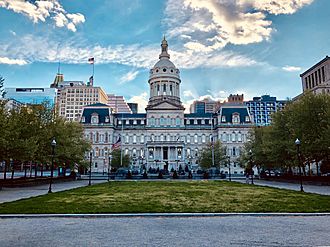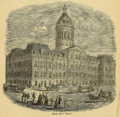Baltimore City Hall facts for kids
Quick facts for kids Baltimore City Hall |
|
|---|---|

Baltimore City Hall in April 2020
|
|
| General information | |
| Architectural style | Second Empire style, a Baroque revival |
| Location | 100 North Holliday Street, (between East Lexington and Fayette Streets), facing City Hall Plaza/War Memorial Plaza. Baltimore, Maryland 21202 |
| Town or city | Baltimore, Maryland |
| Country | United States |
| Coordinates | 39°17′28″N 76°36′39″W / 39.291°N 76.61073°W |
| Completed | 1867–1875 |
| Cost | $50,271,135.64 |
| Client | Mayor and City Council of Baltimore |
| Technical details | |
| Size | ~270 Feet |
|
Baltimore City Hall
|
|
| Lua error in Module:Location_map at line 420: attempt to index field 'wikibase' (a nil value). | |
| Location | 100 N. Holliday St., Baltimore, Maryland |
| Area | less than one acre |
| Built | 1867 |
| Architect | Frederick, George A.; Bollman, Wendel |
| Architectural style | Renaissance, French Renaissance Revival |
| NRHP reference No. | 73002180 |
| Added to NRHP | May 8, 1973 |
| Design and construction | |
| Architect | George Aloysius Frederick, (1842–1924) |
Baltimore City Hall is the main government building for the City of Baltimore in Maryland. It's where the Mayor and the City Council have their offices. Many other city departments and groups also work here.
The building stands on a city block bordered by East Lexington Street, Guilford Avenue, East Fayette Street, and North Holliday Street. It faces City Hall Plaza and the War Memorial Plaza. This six-story building was designed by a young architect named George Aloysius Frederick when he was only 22 years old. He designed it in the Second Empire style, which looks a bit like the older Baroque style. It has cool Mansard roofs and fancy windows.
History of Baltimore City Hall
The first stone for the new City Hall was placed in October 1867. This was a big event, and a famous photo was taken of the ceremony. The area around it was full of history. Nearby was the Holliday Street Theatre, where the poem "The Defence of Fort McHenry" was first performed in 1814. This poem later became "The Star-Spangled Banner", our national anthem!
The huge new City Hall was officially opened on October 25, 1875. It was amazing because it cost $200,000 less than the $2.5 million that was set aside for it. This was a big deal back then!
The idea for a new city hall and some early designs were made before the American Civil War. But the actual building, based on Frederick's design, didn't start until 1867. It took eight years to finish. The building cost more than $2 million (in money from the 1870s).
Baltimore City Hall is mostly built from many layers of brick. Its outside walls are covered with white marble. This marble came from quarries in Baltimore and Baltimore County. Just the marble itself cost $957,000! The rounded dome on top of the building was designed by a Baltimore engineer named Wendel Bollman. He was famous for his iron railroad bridges. When it was built, the dome's cast iron roof was one of the biggest of its kind.
Renovations and Repairs
By the end of World War II, City Hall was starting to look old and worn out. The slate roof was leaking, and parts of the marble outside were wearing away. The heating, cooling, and electrical systems also needed to be replaced. Even the iron dome's parts had rusted, and many plates were cracked.
In 1959, a piece of iron decoration weighing 15 pounds fell 150 feet into a meeting room! Because of these problems, the city decided in 1974 to fix up the old City Hall instead of building a new one.
The renovation project took two years and cost $10.5 million. During this time, the special meeting rooms were restored. The office space was also doubled. The dome was even taken apart and put back together again! After the renovation, the Mayor, City Council, and other city departments moved back in. The building now had almost twice as much usable space. This was done by adding two extra floors and turning old storage areas into offices.
In 2009, a check of the building found that parts of the marble outside were cracked and crumbling because of age. The city approved spending $483,000 to fix these issues that same year.
Images for kids
See also
 In Spanish: Ayuntamiento de Baltimore para niños
In Spanish: Ayuntamiento de Baltimore para niños


